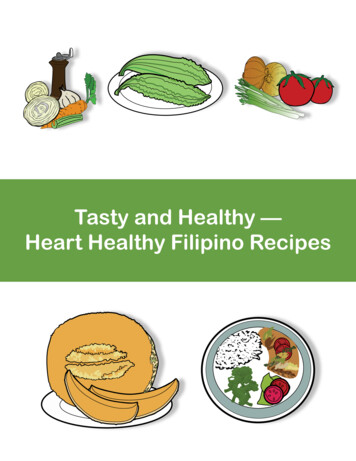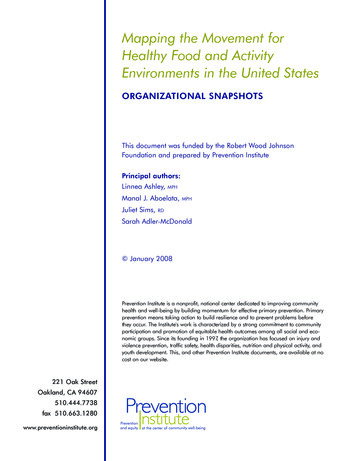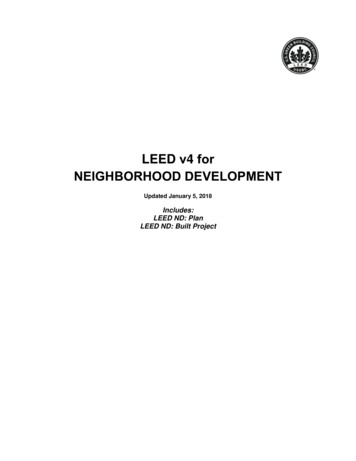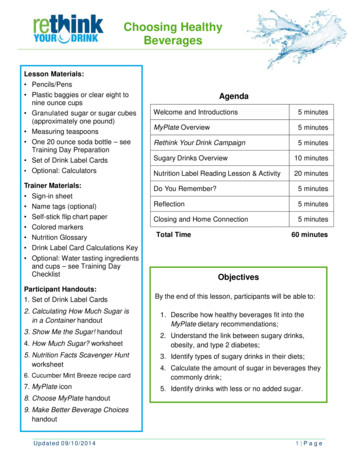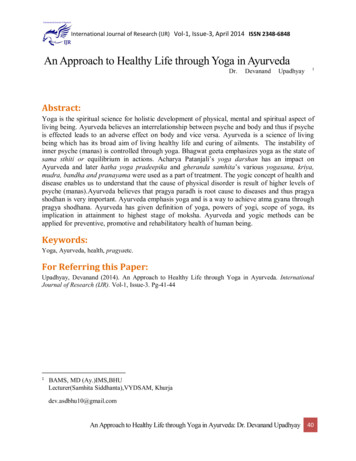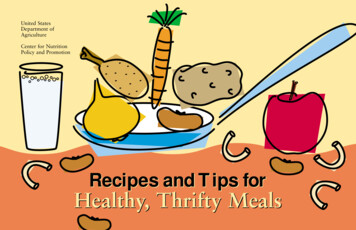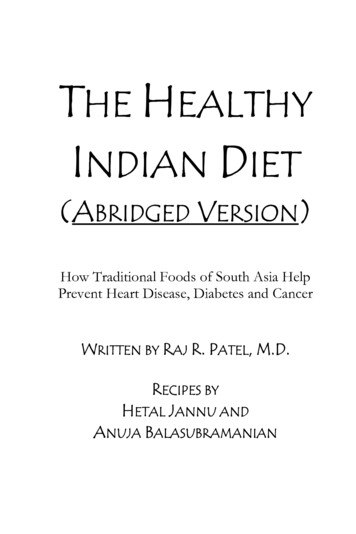
Transcription
THE HEALTHYINDIAN DIET(ABRIDGED VERSION)How Traditional Foods of South Asia HelpPrevent Heart Disease, Diabetes and CancerWRITTEN BY RAJ R. PATEL, M.D.RECIPES BYHETAL JANNU ANDANUJA BALASUBRAMANIAN
Copyright Raj R. Patel, Anuja Balasubramanian & Hetal Jannu, 2011“The Healthy Indian Diet”TM is a registered trademark under applicationwith the U.S. Patent and Trademark Office.All rights reserved.Inquiries should be addressed to:Raj R. Patel, M.D.PO Box 667234Houston, Texas 77266RajRPatelMD@gmail.comFirst EditionFirst Printing (June 2011)Cataloguing-in-Publication DataThe Healthy Indian Diet by Raj R. Patel, Anuja Balasubramanian, and Hetal Jannup. cm.Includes bibliographical references and indexISBN-13: 978-1461122135ISBN-10: 14611221391. Health & Fitness – Food and Diet.2. Cooking – Indian Food.3. Health & Fitness – Prevention.Library of Congress shelving number pendingDewey decimal number pendingAuthor’s note: Although information herein is based on the author’s extensiveexperience and knowledge, this book is not intended to be a substitute forcare and counsel provided by medical professionals. All matters regardingyour health require medical supervision. Neither the author nor the publishershall be liable or responsible for any loss or damage allegedly arising fromany information or suggestion in this book. Consult your physician beforeadopting advice in this book if you have any known or unknown medicalcondition.Printed in the United States of Americaby Sun Health Press, subsidiary of Surya Health, L.L.C.at CreateSpace, L.L.C.Cover Design by Anita AmitNo part of this book may be reproduced or utilized in any form or by any means, electronicor mechanical, including photocopying, recording or by any information storage and retrievalsystem without permission in writing.
TO OUR FAMILIES– Anuja, Hetal & Raj
TABLE OF CONTENTSIntroduction . 1Power of the Healthy Indian Diet . 6PART I: THE SCIENCE OF CHRONIC DISEASES AND FOOD BASICS . 11Epidemic of Chronic Disease . 12Understanding Chronic Disease . 24Basic Food Science . 49PART II: THE HEALTHY INDIAN DIET . 65What Are Diets. 66Basic Principles of the Healthy Indian Diet . 75Foundations of the Healthy Indian Diet . 77Mostly Plants . 77Kinds of Vegetables and Fruits . 83Dals and Other Legumes . 89Spices . 91Dahi and other Fermented Dairies . 98Pickles and Chutneys. 101Brown Rice and Whole Grains . 102Cooking Oils and Ghee . 106Tree Nuts . 110Modern Elements that Don’t Belong . 113Note to Indian and South Asian Readers . 117PART III: HEALTHY INDIAN RECIPES . 123Vegetable Jalfrezi – Vegetable Stir Fry . 124Shahi Paneer – Cheese Chunks in Cashew Sauce . 126Asparagus Subzi – Asparagus Side Dish . 128Kumro Chokka – Butternut Squash with Black Chickpeas . 130
Baingan ki Subzi – Roasted Eggplant Side Dish . 132Chana Masala (or Chole) – Garbanzo Beans Curry . 134Lauki Koftas – Bottle Gourd & Chickpea Flour Dumplings . 136Sem Phali – Lima Bean Curry . 138Tadka Dal Fry . 140Whole Green Mung Dal – Mung Bean Soup . 142Dal Makhani – Black Gram Legume Soup. 144Sambar – South Indian Legume Soup. 146Daar – Gujarati Lentil Soup. 148Doi Maach – Bengali Fish Curry. 150Saagwala Murgh – Chicken Curry with Spinach . 152Oats and Brown Rice Dosa – Savory South Indian Crepe . 154Basic Brown Rice. 156Masala Brown Rice – Spiced Brown Rice. 158Quinoa Pulao – Quinoa Pilaf . 160Paratha – Whole Wheat North Indian Bread. 162Dhebra – Millet and Fenugreek Flatbread. 164Dahi – Homemade Yogurt . 166Palak Raita – Spinach in Spiced Yogurt . 168Pudina Lassi – Mint-Flavored Yogurt Drink . 170Dhaniya ki Chutney – Coriander (Cilantro) Chutney . 172Coconut Chutney . 173Maanga Aavakai – Mango Pickle . 175Homemade Garam Masala (Spice Powder). 177Homemade Curry Powder . 179Shakarkandi Chaat – Sweet Potato Salad . 180Chukundar Kachumber – Beetroot Salad. 182Sambharo – Cooked Cabbage Salad . 183
The Healthy Indian DietINTRODUCTIONHippocrates, the ancient Greek physician known as the Father ofWestern Medicine, once said, “Let food be thy medicine.” Indeed, forhundreds of years before and after him, physicians had little at theirdisposal besides food and other elements found in nature to treatdisease. Millennia of experiments and observations on animals andpeople revealed to pre-modern healers what actually worked, andwhich plants, herbs and spices helped people recover their health andstay well. Unbeknownst to them, foods are made of molecules thatinteract with the molecules making up the human body. Theseinteractions help or harm the body, just like medications.WHY I WROTE A BOOK ON THE HEALTHY INDIAN DIETIn this book, I examine how food can be good medicine, especially inthe context of chronic diseases that have grown to epidemicproportions both here and the world over. I focus on Indian foods,which, according to famous American and European doctors likeMehmut Oz, M.D., David Servan-Schreiber, M.D., and Dean Ornish,M.D, are very beneficial to human health. I initially found this positionto be odd because, growing up as an Indian-American kid, I developedthe impression that Indian food was bad for your health. This cognitivedissonance between what I knew growing up and this new perspectiveon Indian food compelled me to find out who, in fact, was right.I also examined the latest published experiments and observationsspeaking on the relationship between diet and human health. The pastcouple years of this journey have bore some fruit, as the pieces havestarted to come together. I now realize that the modern Indian diet isindeed bad for you. It was surprising to learn exactly what in themodern Indian diet was bad: whereas I once thought the rash of heart1
Introductionattacks among middle-aged men in my community was explained byeating a lot of ghee, I could see that thanks to new knowledge, it wasn’tthe ghee but actually refined grains, starchy vegetables, and sugar.THE HEALTHY INDIAN DIETThe traditional Indian diet is what these famous doctors are actuallyreferring to, and the foods in this diet in fact do the body a lot ofgood. Like the Mediterranean Diet, the most famous and well-studiedof traditional diets, the traditional Indian diet is low on refined grains,starchy vegetables, and sugar. This means it is full of whole grains,leafy vegetables, and spices. Whereas other traditional diets fromaround the world are found to be good for people, what sets theIndian diet apart from the others is the presence of spices liketurmeric and black pepper in everyday meals.Spices also tie all regional diets of the Indian subcontinenttogether, just like olive oil and fatty fish tie all the variousMediterranean regional diets together. In the past decade or so, spiceshave been under the microscope lens of modern science, and manyhave been found to be astonishingly beneficial. The same is true ofother elements of a traditional or healthy Indian diet. Unlikemedications, spices and foods tend to have low, if any, adverse effectsin most people, and no side effects whatsoever in those who areaccustomed to eating them.I have written this book for two reasons. One, I want to highlightwhat modern science tells us about how various foods help us stayhealthy and improve our well-being, especially in the context ofdiseases such as obesity, heart disease, diabetes, and cancers. Two, Iwant to propose an alternative to the Mediterranean Diet based on thetraditional cuisines of India, which includes many nutrient-densewhole foods. To give a compelling alternative, I have had to definewhat a healthy Indian diet means. I hope you find the concepts easy tograsp, that the evidence persuades you to my way of thinking on thisissue, and that you allow for the elements of the healthy Indian diet to“be thy medicine.”2
The Healthy Indian DietHOW TO READ THIS BOOKMany pages of this book are devoted to the science of foods, howdiets affect the development of chronic diseases, and what constitutesa healthy Indian diet. These sections can get quite technical, and I havewritten them for readers who are intellectually curious about how thebody works and how the foods we eat every day influence our overallhealth. These pages also give credibility to the idea that the healthyIndian diet is indeed good for you.However, if you want to know what constitutes a healthy Indiandiet and then begin preparing meals that fit the profile, skip to Part IIand begin reading from there. I intended to make this book practical,and I have included recipes at the end thanks to two wonderfulwomen, Hetal and Anuja, who teach people how to make Indiandishes – many of them healthy.There is a section toward the end of the book more specific topeople from the Indian subcontinent. I started this project with this inmind: people all over the world are suffering from chronic diseases,but people of South Asian descent suffer them in greater numbers.Additionally, I have included a Glossary to help readers with certainterms that I have elected to use the Hindi word for, such as haldi(turmeric powder).DIET, NOT DIETINGBefore going on, I want to make a clear distinction between “diet” and“dieting.” This book focuses on a daily diet or pattern of foods,leaving you to pick and choose which elements you want to emphasizebased on your (and your family’s) tastes. I do not get specific abouthow much of something to eat, or indeed how often. It is useful tothink of the advice here as more like guidelines than fixed rules.If you wish to follow a prescription of certain foods in specificamounts for a more specific goal, such as losing weight or gainingmuscle, then this is not the book for you. While you can emphasizeelements of the healthy Indian diet to help lose weight, I focus on3
Introductiondescribing basic elements of Indian foods that compel readers toadhere to the diet in the long-term, motivated by the knowledge thatthe diet is healthy, and because the diet is tasty.My approach emphasizes that changing your diet to somethinghealthier, whether you already eat Indian food or not, is difficult. Sorather than trying to switch overnight, I hope you aim to change yourdiet gradually. For example, don’t throw out the white riceimmediately and replace it with brown rice. Instead, cook brown ricetwo or three nights a week, substituting meals where you have whiterice. After some weeks, if you find you like the taste of brown rice, orfeel it is important to switch, then keep going.Fortunately, this kind of diet – a change in the patterns of foodsyou eat – is easier to stick with. After all, today’s dishes have comefrom hundreds of years of cooking various combinations of foods,and they have made it this far because they taste good and provide thebody with the nutrition it needs.THIS IS NOT AYURVEDAIf you want to learn about Ayurveda, the Indian tradition of health andhealing, please refer to a book based on that specific subject, not thisbook. For the uninitiated reader, Ayurveda is a millennia-oldmetaphysical system based on how five elements – fire, water, earth,air, and ether – combine to make the seven constituent elements ofthe human body. Ayurvedic practit
Sweet potatoes – 3 medium (boiled, peeled and chopped) Cucumber – 1 (peeled and chopped) Clementine oranges (or any favorite variety) – same amount as cucumber, chopped segments Salt – to taste Red chili powder – to taste.
